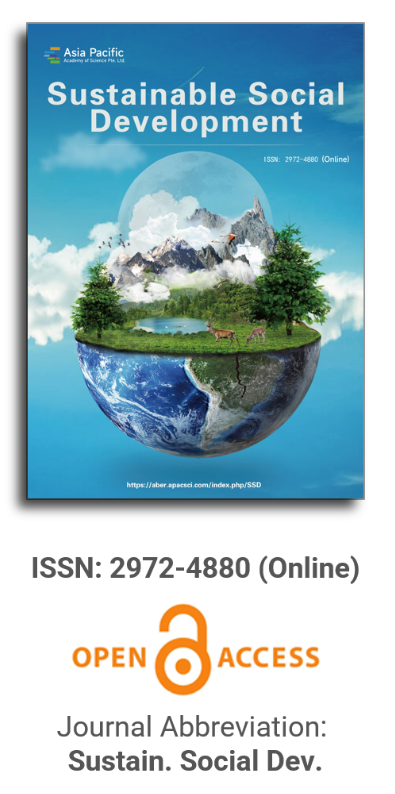
Asia Pacific Academy of Science Pte. Ltd. (APACSCI) specializes in international journal publishing. APACSCI adopts the open access publishing model and provides an important communication bridge for academic groups whose interest fields include engineering, technology, medicine, computer, mathematics, agriculture and forestry, and environment.

Energy poverty in Brazil: A systematic analysis
Vol 2, Issue 1, 2024
Download PDF
Abstract
The utilization of firewood for cooking in approximately 13 million Brazilian households in 2022 raises pressing concerns regarding its multifaceted impact on key development indicators. This impact stems from the profound connection between access to modern energy sources and fundamental rights, including education, health, housing, and leisure. Despite Brazil’s remarkable diversity in its energy matrix, the equitable distribution of this essential resource remains a persistent and significant challenge. To construct the present work, it was undertaking a systematic review of the technical literature, uncovering a stark disparity in energy access closely correlated with income levels. This inequality in energy access underscores the urgent need for comprehensive analysis and intervention. The present work endeavors to delve deeper into this complex issue, aiming to illuminate the profound implications of both broad energy access and the consequences of energy deprivation on individual well-being and broader socio-economic dynamics. Also, this work aims to provide a holistic understanding of the challenges faced by communities with limited access to modern energy sources and, concurrently, the opportunities and improvements that can be brought about through enhanced energy accessibility. In addition, this study seeks to identify and evaluate potential solutions to address this critical issue. This work is driven by the recognition that equitable energy distribution is not only a matter of environmental sustainability but also a fundamental human right, pivotal to social and economic progress.
Keywords
References
- Ochoa RG. Energy poverty in Latin America (Spanish). Available online: https://repositorio.cepal.org/server/api/core/bitstreams/79cc961b-7908-4fce-a7dd-133d484c1be7/content (accessed on 30 November 2023).
- European Commission. The energy poverty advisory hub. Available online: https://energy.ec.europa.eu/topics/markets-and-consumers/energy-consumer-rights/energy-poverty_en (accessed on 30 November 2023).
- Dicks G. World outlook. Economic Outlook. 1987; 11(4): 1–8. doi: 10.1111/j.1468-0319.1987.tb00425.x
- Instituto Brasileiro de Geografia e Estatística. Available online: https://cidades.ibge.gov.br/brasil/panorama (accessed on 18 August 2023).
- Empresa de Pesquisa Energética. Residential electricity consumption by income classes. Available online: https://www.epe.gov.br/sites-pt/publicacoes-dados-abertos/publicacoes/PublicacoesArquivos/publicacao-729/FactSheetConsumoPorClassesDeRenda_Final09032023.pdf (accessed on 18 August 2023).
- Instituto Brasileiro de Geografia e Estatística. Annual continuous national household sample survey (Portuguese). Available online: https://sidra.ibge.gov.br/tabela/6739 (accessed on 17 August 2023).
- International Energy Agency. Energy Access Outlook 2017: From Poverty to Prosperity. International Energy Agency; 2017.
- Giannini Pereira M, Vasconcelos Freitas MA, da Silva NF. The challenge of energy poverty: Brazilian case study. Energy Policy. 2011; 39(1): 167–175. doi: 10.1016/j.enpol.2010.09.025
- United Nations Brazil. Available online: https://brasil.un.org/pt-br/sdgs/7 (accessed on 15 September 2023).
- González-Eguino M. Energy poverty: An overview. Renewable and Sustainable Energy Reviews. 2015; 47: 377–385. doi: 10.1016/j.rser.2015.03.013
- Zimmermann CR. Social programs from a human rights perspective: The case of the Lula administration’s family grant in Brazil (Portuguese). Revista Internacionais de Direitos Humanos. 2006; 4: 144–159. doi: 10.1590/S1806-64452006000100009
- Coelho ST, Sanches-Pereira A, Tudeschini LG, et al. The energy transition history of fuelwood replacement for liquefied petroleum gas in Brazilian households from 1920 to 2016. Energy Policy. 2018; 123: 41–52. doi: 10.1016/j.enpol.2018.08.041
- Instituto Brasileiro de Geografia e Estatística. Continuous national household sample survey (Portuguese). Available online: https://www.ibge.gov.br/estatisticas/sociais/trabalho/9171-pesquisa-nacional-por-amostra-de-domicilios-continua-mensal.html (accessed on 21 December 2023).
- Mazzone A. Decentralised energy systems and sustainable livelihoods, what are the links? Evidence from two isolated villages of the Brazilian Amazon. Energy and Buildings. 2019; 186: 138–146. doi: 10.1016/j.enbuild.2019.01.027
- Gioda A. Residential fuelwood consumption in Brazil: Environmental and social implications. Biomass and Bioenergy. 2019; 120: 367–375. doi: 10.1016/j.biombioe.2018.11.014
- Agência Nacional de Energia Elétrica. Analysis Report: Operation Performance in Transmission Facilities (Portuguese). Agência Nacional de Energia Elétrica; 2016.
- Instituto Brasileiro de Geografia e Estatística. Demographic census 2000: General characteristics of the population: Sample results. Available online: https://biblioteca.ibge.gov.br/visualizacao/periodicos/83/ cd_2000_caracteristicas_populacao_amostra.pdf (accessed on 21 December 2023).
- Balanço Energético Nacional. Available online: https://www.epe.gov.br/pt/publicacoes-dados-abertos/publicacoes/balanco-energetico-nacional-2023 (accessed on 29 December 2023).
- Comisión Económica para América Latina y el Caribe. The matrix of social inequality in Latin America (Spanish). Available online: https://www.cepal.org/sites/default/files/events/files/matriz_de_la_desigualdad.pdf. (accessed on 30 November 2023).
- ELETROBRÁS. Areas of activity: Light for all program (Portuguese). Available online: https://eletrobras.com/pt/Paginas/Luz-para-Todos.aspx (accessed on 28 December 2023).
- Gouveia JP, Bessa S, Palma P, et al. Energy poverty national indicators: Uncovering new possibilities for expanded knowledge. Available in: https://energy-poverty.ec.europa.eu/system/files/2023-10/EPAH2023_2nd%20Indicators%20Report_Final_0.pdf (accessed on 30 November 2023).
- Gaye A. Access to energy and human development. Available online: https://hdr.undp.org/system/files/documents/gayeamiepdf.pdf (accessed on 28 December 2023).
- Instituto Brasileiro de Geografia e Estatística. Family budget survey 2017–2018: Expenditure profile in Brazil (Portuguese). Available online: https://biblioteca.ibge.gov.br/visualizacao/livros/liv101761.pdf (accessed on 13 October 2023).
- Instituto Brasileiro de Geografia e Estatística. Table 6739—Households and residents, by type of fuel used in food preparation (Portuguese). Available online: https://sidra.ibge.gov.br/tabela/6739 (accessed on 12 September 2023).
- Instituto de Pesquisa Econômica Aplicada. GDP performance in the first quarter of 2023 (Portuguese). Available online: https://www.ipea.gov.br/cartadeconjuntura/index.php/2023/06/desempenho-do-pib-no-primeiro-trimestre-de-2023/ (accessed on 16 September 2023).
Supporting Agencies
Copyright (c) 2023 Hocevar Luciano Sergio, Alves Carine Tondo, Pereira Jadiel dos Santos, Bezerra Gabrielly de Moura
License URL: https://creativecommons.org/licenses/by/4.0/

This site is licensed under a Creative Commons Attribution 4.0 International License (CC BY 4.0).

Prof. Kittisak Jermsittiparsert
University of City Island, Cyprus






It is with deep regret that we announce the cancellation of the Forum on Sustainable Social Development & Computing and Artificial Intelligence, originally scheduled for June 15, 2025.

